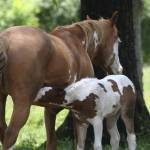Planning on an Early Foal? Start Preparing Now

If you’re looking to have four new hooves on the ground early next year, then you’d better start now! After all, failing to plan is planning to fail, and when it comes to breeding horses—renowned for their conservative pregnancy rates compared with other domestic animals—all the cards should be stacked in the mare owner’s favor.
“As seasonal polyestrous animals, mares come into heat when days are long and take a reproductive hiatus when days are short. Therefore, the breeding season for mares needs to be moved up a few months to have foals born closer to the start of the calendar year,” explained Catherine Whitehouse, M.S., a nutrition advisor for Kentucky Equine Research.
Advancing the breeding season can be facilitated using pharmaceuticals, but a simpler way is through “vitamin L,” or manipulation of light, sometimes referred to as photoperiod.
Adding artificial light to the beginning or to the end of the day starting in late November or early December (in the Northern Hemisphere) will trick a mare into believing daylight hours are lengthening and spring is approaching. The mare should be exposed to light, both natural and artificial, for a total of 16 continuous hours each day. A single 100-watt incandescent lightbulb placed in a mare’s stall may do the trick, though many mare managers believe that the light should be bright enough for a newspaper to be read easily in the darkest corner.
The lighting regime should start 60-90 days before the anticipated breeding date. By this time, normal cycling is typically evident based on reproductive examination, though some mares require longer phototropic stimulation. So, for example, if a mare is to be bred in February, the lighting program should begin no later than early December. Every effort should be made to consistently keep mares exposed to the required light, as even a two- or three-day pause in the lighting schedule can completely reset a mare or even cause the mare to return to anestrus (period of sexual inactivity).
As simple as this seems, there are some drawbacks to consider. In addition to an elevated electric bill, mares are usually maintained indoors during their light treatment. Having mares stalled will increase bedding costs as well as labor costs associated with mucking stalls that would otherwise be empty if mares were maintained on pasture. Further, decreased turnout can potentially increase the occurrence of stereotypic behaviors and colic in susceptible mares.
“Perhaps most important, however, is the tendency for mares to slip their winter coats early when exposed to photoperiod manipulation,” said Whitehouse. “Mares under lights often have slick, summerlike coats in midwinter, which will necessitate an added measure of management if mares are kept outside, including blanketing.”
As an alternative, wearable light devices allow mares to remain on pasture while simultaneously being exposed to the requisite amount of light.
In addition to light, be certain your mare passes her annual breeding soundness examination and receives supplemental omega-3 fatty acids, including docosahexaenoic acid (DHA), to support reproductive health. Kentucky Equine Research offers EO-3 containing marine-derived fatty acids. Each serving of EO-3 provides close to 10,000 mg of omega-3 fatty acids, including 6,750 mg EPA and DHA.








